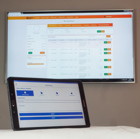Integration: a new way

Dave Lapsley considers the connected future and points to new approaches which are making integration for smart buildings much easier.
One thing that we can perhaps all agree on is the inevitability that smart buildings will increasingly benefit from connectivity to remote locations. Cloud-based solutions will be the infrastructure that smart buildings are based on. They will also provide the conduit for data that can be analysed to see how occupant patterns and requirements affect the performance of the building – and vice versa.
The integrated technology behind ‘smart or ‘intelligent’ buildings is more evolved than most people might think. Any electrical or mechanical system within a building including the HVAC, lighting, security, access, lifts and telephones can be integrated into one highly intelligent system that is able to function almost as a single entity.
The technical capability is there and has been for some time, so why do we continue to see buildings where systems are disjointed, resulting in wasted energy and inconsistent environmental conditions which will inevitably affect the mood, morale and wellbeing of occupants?
No engineer has ever claimed that integration is simple, and the challenge compounded by issues such as manufacturers overstating the ability of products to integrate or failing to provide suitable interfaces. Lack of skills and training in the face of more complex technology and rising client expectation are also significant issues.
If we want to achieve the promise of smart buildings, and harness the technology that exists today, the question is how can we make it easier to achieve a fully integrated building?
An important potential opportunity lies in the rise of standardised IP networking. It is already becoming more common in the world of building automation and it offers a realistic pathway to easier integration. There will always be projects where techniques involving wireless networks are not appropriate, but this will typically become a rarity as wireless technology becomes more flexible.
Integration in any industry is hampered by disparate, nonstandard systems
|
In the Bubll Bubll is a software solution that can be installed onto mobile computing devices such as phones and tablets. Once paring is complete, connection can be established over WiFi or hard-wired networks to enable the device to scan building automation systems; automatically creating, simple-to-navigate user interfaces without the need for complex engineering. The system includes a native occupant wellbeing interface and the ability to provide operational and occupant emotional data from disparate systems to either local or cloud-based server solutions. Condition-based monitoring and analysis help to ensure buildings perform efficiently. Bubll has in-built security that meets the IT industry’s highest standards. Successful testing has been completed with a large proportion of industry systems: if a system complies with industry-standard open protocols, the connection process will be simple. |
Smart devices are everywhere, but the problem is that the data they carry is in different formats – it has inconsistent, non-standard naming conventions, usually with very few descriptors to enable engineers to understand what they’re connecting.
To an engineer attempting to write an integrated building management system programme, the boiler and the AHU may be impossible to differentiate in terms of their device coding. Sorting out that kind of issue takes a lot of time. It also means that the boiler may well be capable of delivering data on its own energy performance but picking that up and drawing it into a building-wide data system is very challenging.
In the USA, the Continental Automated Buildings Association (CABA) has been working on this issue in relation to building controls. The Association is attempting to create a standard format for building automation that will smooth the way to truly intelligent buildings through easier integration. Its initiative, Project Haystack, which has seen involvement from leading industry experts, is providing data sets that are standardised, allowing conventions to be established.
However, this process of establishing conventions will take time. An alternative approach is to achieve control without integration. This is being made possible by ‘lightweight’ coding protocols, combined with known but adaptable data sets. What this means for controls engineers, and building users too, is that mobile phones and tablets can connect simultaneously to multiple control nodes in different systems. This enables control without integration.
Technologies that can easily be incorporated into this sort of system include: Smart alarming; voice interfacing; way finding; room booking; and camera feeds. Each of these presents all sorts of opportunities for improved building interfaces. If used to create a single system, it could lead to the more straightforward creation of agile and lean working environments where a building not only understands it occupants but applies requirements in their specific localities.
Data released by GSMA Intelligence suggests that the number of mobile computing devices now outnumbers the global population that owns them. No other technology has impacted on this scale the way that the mobile device has.
Surely it is common sense to make use of the power that a large percentage of us already carry everywhere we go? It may not be the case that all mobile devices are connected to our buildings, but a small percentage of several billions is enough to create a significant opportunity for the controls sector.
Dave Lapsley is managing director of the Econowise Group







